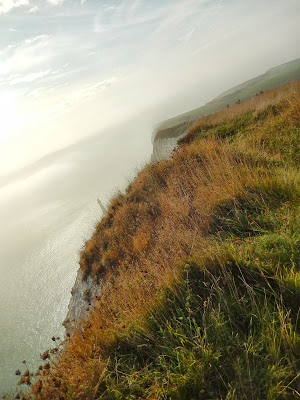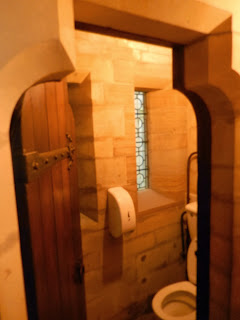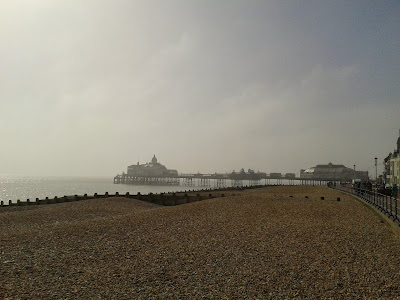Ha! Got your attention!
While my day has been somewhat less than a no-good-terrible-horrible-very-bad-day, I nevertheless have found opportunity to wallow in a little self pity, as I have in the past 24 hours:
1) Sprained an ankle and fallen flat on my face into a gritty puddle in front of no less than half the population of Edinburgh at a popular bus stop, where two very nice gentlemen helped me from my Prostration in the Puddle as I spit out bits and pieces of Edinburgh rain, dirt, and rubbish.
2) Fallen into the grips of a nasty Scottish chest cold.
3) Been forced to throw out seven pairs of washed socks because after five days hanging on my radiator rack, they are still soaking wet and starting to grow mold and smell terrible. Ain't nobody got time for that.
4) It has rained for 14 days straight.
I, of course, blame Obamacare for these misfortunes which have befallen me.
So to cheer myself up, I will write of happier days: my week in Eastbourne, "The Sunniest Spot in Great Britain."
 |
| You really can't appreciate it in this picture, but I'm very close to the edge of a cliff with a 5,000,000 foot drop. |
I'd always wanted to visit the South Downs in East Sussex, where some of my very favorite British mysteries (Laurie King's Mary Russell novels) are set, and walk along the white chalk cliffs. I had a few local archives to visit, but needed to be relatively close to London, so I took the chance to convalesce by the sea.
For a long time, the seaside was considered bad for your health (too damp), but by the early 1800s (as cities were becoming grosser and more densely populated), doctors began singing a different tune about the health benefits of the seaside. So little fishing towns all over the South of England were revamped (or created anew) into fashionable resort towns for the upper and middle classes to escape to. In Eastbourne's case, the soon-to-be Duke of Devonshire, William Cavendish, poured a bunch of money into building a town "for gentlemen by gentlemen," complete with huge sandstone mansions, pavillions, bandstands, promenades, and big creepy pier.
The whole town is very Victorian, and a little other-worldish. I can't really explain it properly. Sunny and Eerie.
Demographically, all the gay folks went to Brighton (England's version of Provincetown) and all the elderly folks went to Eastbourne. I'm pretty sure the average age of an Eastbourne resident is 60 (I hasten to add for the benefit of my 60-year-old father that 60 is not in and of itself "elderly," but as an average is quite high). It's the warmest place in England. It's relatively cheap to live in. And it became a popular spot for convalescent hospitals in both World Wars, hospitals which have now been converted into retirement apartments. Every other house, it seems, is either a guesthouse or an assisted living home (Unlike in the U.S. where assisted living facilities are almost exclusively run by non-local corporations, in the UK, assisted living facilities tend to be family-run in small buildings or houses, overseen and with costs paid by the government.) The charity shops all deal primarily in used bikes and used Jazzy Scooters. As you walk down the Promenade, you can always hear the hum of a Jazzy Scooter. There are even Jazzy Scooter recharging stations throughout town.


Here's me on the Hop-On-Hop-Off bus (the only way to get to Beachy Head by public transport):
 |
| I'm obviously very bad at selfies, but you get my point. |
I rented a bike from a really nice old couple, which made getting around a bit easier. Except for BeachyHead, which is practically up in the clouds, Eastbourne is pretty flat. The pitiful lock it came with wouldn't have lasted a night in Hyde Park, but it held up in Eastbourne. There were some junkie types and angry youths about, but, like I said, mostly geriatrics.
 |
| They have little bike seatbelts on the trains. |
Beachy Head is Britain's highest sea cliff (or cliffs more like), rising at some points, nearly 600 feet above sea-level. The White Cliffs of Dover are more recognized because they are always pictured in WWII movies, but Beachy Head and The Seven Sisters are much more dramatic.
 |
| You really need people in the picture to give you a frame of reference. |
 |
| The angle of this shot makes it feel like everyone is about to slip off into the ocean. |
 |
| Nothing but sky and the deep blue sea. |
These cliffs are actually pretty scary since until you are right at the edge, the landscape looks like this:
 |
| Looking across the Downs to Birling Gap (the only place you can access the beach below from without falling to your death). |
But, the first time I went, there was a fog so heavy that it was hard to see ten feet in front of you at times. At one point, as the bus made its ascent, you really just had to trust that the driver could see the road, because it felt like we were barreling along into a cloud as the guide recording told us about the dramatic cliffs we were supposed to be seeing.
So if you weren't really paying attention, you could conceivably just walk right over.
And as a bunch of crosses on the edge eerily remind you, Beachy Head is a very "popular" suicide spot. One of the crosses marked the place where a 13 year old boy jumped off.
Creepy in a different way was Eastbourne's entertainment pier, which has been standing (without much renovation, it seems) since the 1860s. This isn't a fishing pier like we have dotting the coastline of South Carolina. It's more like Navy Pier (except more rickety) in Chicago. It has a huge pavillion, a theatre, a few shops and restaurants, a camera obscura tower. Now, I have a kind of phobia of big metal things in water, so I felt quite brave walking on this contraption.
 |
| The Pavilion in the mist. |
 |
| A little rickety looking, right? It's not just me. |
 |
| A view at sunset. My guesthouse was only a block away from the Promenade, so I caught a few sunsets. |
 |
| A view from the edge. |
 |
| You could see the green water below, between boards that sometimes wobbled. |
 |
| I get a bit woozy just looking at this. I feel like someone would probably get murdered here in Foyle's War. |
The best part about the Pier was taking pictures of it from afar and getting off of it, to have a nice seaside lunch: Fish and Chips without the fish (the fish was a bit too authentic for my liking...I don't like scales).
On one of my last days, I took a bike/train ride to Arundel Castle, a bit inland. Arundel is a restored medieval castle built in 1067 by one of William the Conquerer's cronies, Roger de Montgomery. It got passed around a lot in the Dark Ages, but eventually became the seat of the Duke of Norfolk after the English Civil War. It's been a Roman Catholic house for ages, and has a real Brideshead Revisited feel to it, lots of marian statuary and elaborate triptychs.
 |
| Now this is what a castle ought to look like. |
 |
| The Duke has an extensive collection on MG. This is what Maisie Dobbs drives! |
 |
| No castle is complete without ostriches. |
 |
| A nice mix of old and new. |
 |
| Cheap gardeners. |
 |
| Nom, nom, nom! |
 |
| The keep, I want to say? |
 |
| This is where, I imagine, a lady in waiting would sit with her embroidery. |
 |
| Found a magnolia tree that reminded me of home. |
 |
| It's Fall! |
 |
| Some very Catholic-looking tomb covers. |
And last, but not least, the best (and most discouraging) water fountain ever:





































No comments:
Post a Comment